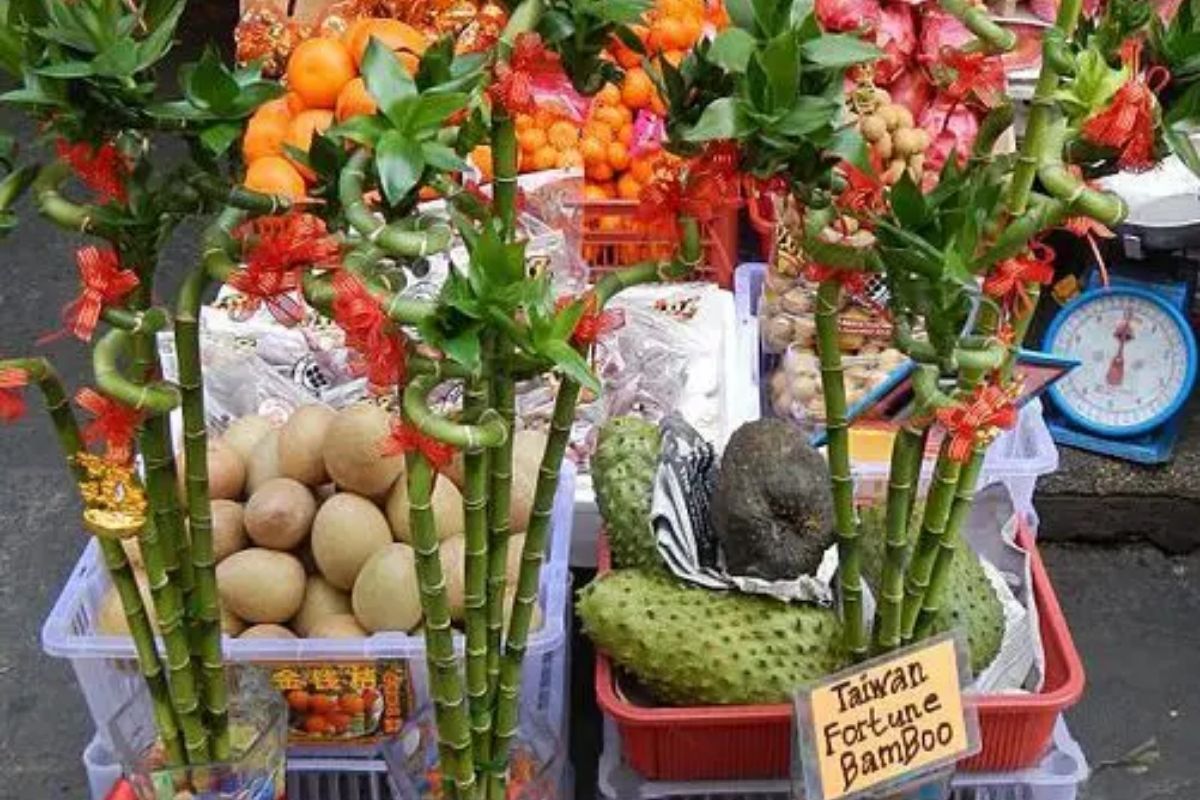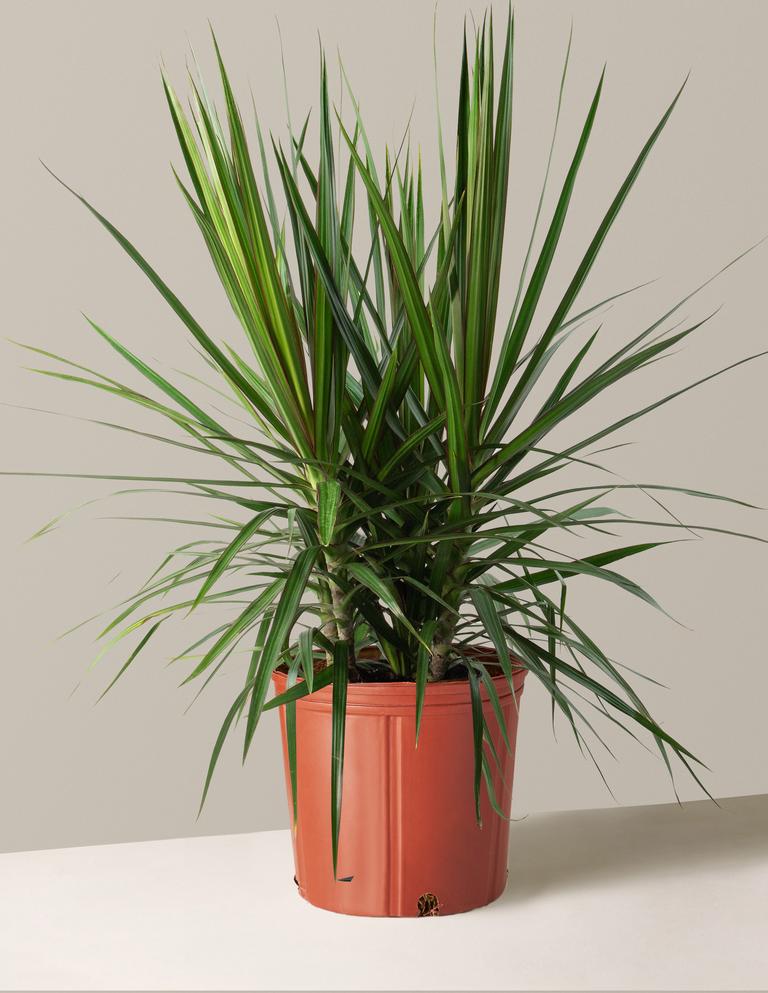Dracaena [Drah-SEE-Nah] are amongst the most popular plants in the houseplant scene. Astoundingly, there are approximately 120 types of dracaena ranging in size, shape, color and personality! The name dracaena stems from the Greek “drakaina,” meaning female dragon. Whether you’re a first time houseplant parent or a seasoned professional looking to spruce up your space, you’re sure to find what you’re looking for in one of the many dracaena varieties.
What Makes Dracaena A Great Indoor Plant
All dracaena types are regarded as hardy, low maintenance and attractive. As tropical plants, their propensity for drought-tolerance makes them exceptionally easy to care for.
A dracaena plant is especially popular as indoor decor because the majority of the genus don’t require much light. In fact, many thrive away from bright sunlight, preferring indirect or low light.
Arguably the best thing about dracaena types as houseplants is that they have been scientifically proven to help with indoor air purification by absorbing and removing various chemical vapors.
Not for the impatient, however, dracaena are slow growing plants. While to some it may be exciting to nurture a plant to maturity over a number of years, many people wonder how to make dracaena plants grow faster. The answer to that is simple: good things take time! Meticulous care will certainly help the process along, but some species take as long as a decade to fully mature.
Perhaps the biggest downside of the dracaena plant is that they are generally toxic to pets and humans if consumed. Be mindful of animals and small children when bringing your new plant home as a curious mouth could mean a trip to the doctor or the vet.
Dracaena Houseplant Varieties
Not unlike most families, physical differences between members of the Dracaena genus are subtle yet important. We’ve put together a “family tree” for you of the most notable types of dracaena.
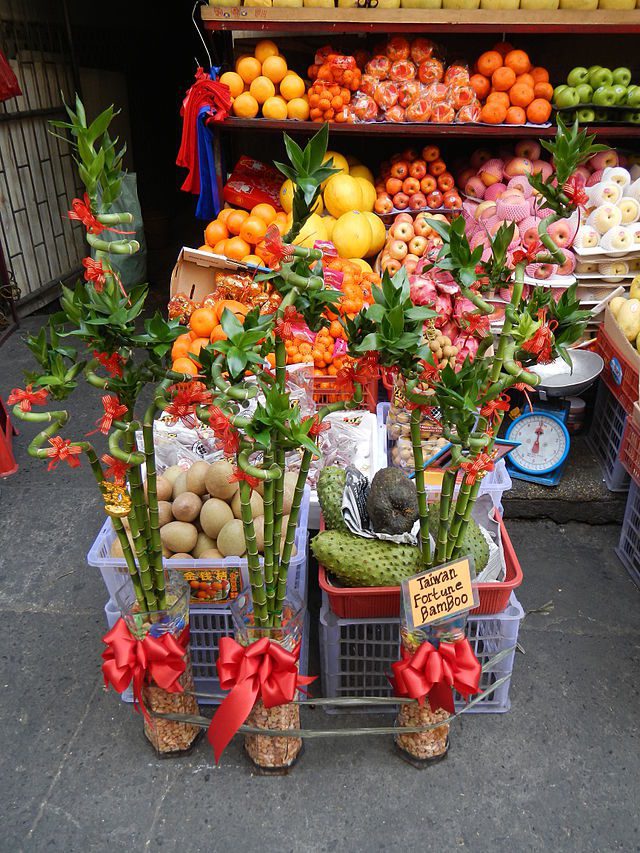
1. Dracaena Sanderiana – “Lucky Bamboo”
Popularized in western culture in connection to the ancient Chinese practice of feng shui, dracaena sanderiana is commonly known as “Lucky Bamboo”. Though its stems resemble bamboo stalks, they are not as closely related as many people believe to “real” bamboo, Bambusoideae. It is said that placing lucky bamboo in the home according to feng shui principles will bring good fortune, prosperity and positive energy to the space and everyone living in it.
How To Identify:
- Growth : 3 – 5 ft tall, 3 – 5ft wide
- Foliage Color: Green lanceolate leaves. Alternate arrangement.
- Discernible Features: Thick, malleable bamboo stalk-like stems, red roots, grows in pebbles or water.
Popular Cultivar:
- Ribbon Plant
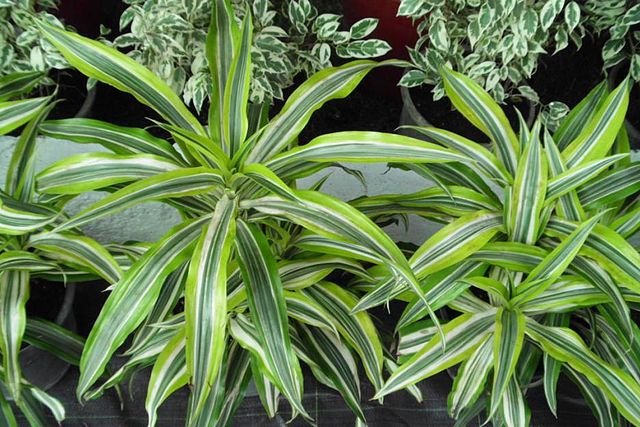
2. Dracaena Fragrans / Dracaena Deremensis – “Corn Plant”
Though it is is rare for the flowers to bloom on Corn Plants when grown indoors,, this dracaena variety was named for the fragrance of its blooms. While the scientific names “dracaena fragrans” and “dracaena deremensis” are used interchangeably for this plant, it is commonly known as a corn plant /cornstalk plant because the way its foliage falls on the stem resembles the leaves of a stalk of corn. This species has some of the most cultivars of any in the dracaena genus, so it’s easy to find a size and foliage color to suit your taste.
How To Identify:
- Growth : 50+ ft! (Likely up to 6 ft indoors)
- Foliage: Broad, generally glossy green lancelot leaves & somewhat bushy foliage resembling that of actual corn plants. Spiral arrangement.
- Discernible Features: One or more woody, cane-like stems with shoots sprouting from the top. Crowns of leaves grow from the shoots giving it a palm-like appearance. Sometimes referred to as “false palms” because as the plant grows its lower leaves fall off and the stem remains bare. Stems can grow up to 1 ft in diameter.
Popular Cultivar:
- Massangeana aka “Mass Cane”
- Janet Craig
- Janet Craig Compacta (Pineapple dracaena)
- Hawaiian Sunshine
- Lemon Lime
- Lemon Surprise
- Limelight
- Warneckii
- Lindenii
- Dorado
- Bausei
- Victoria
- Lisa
- Rikki
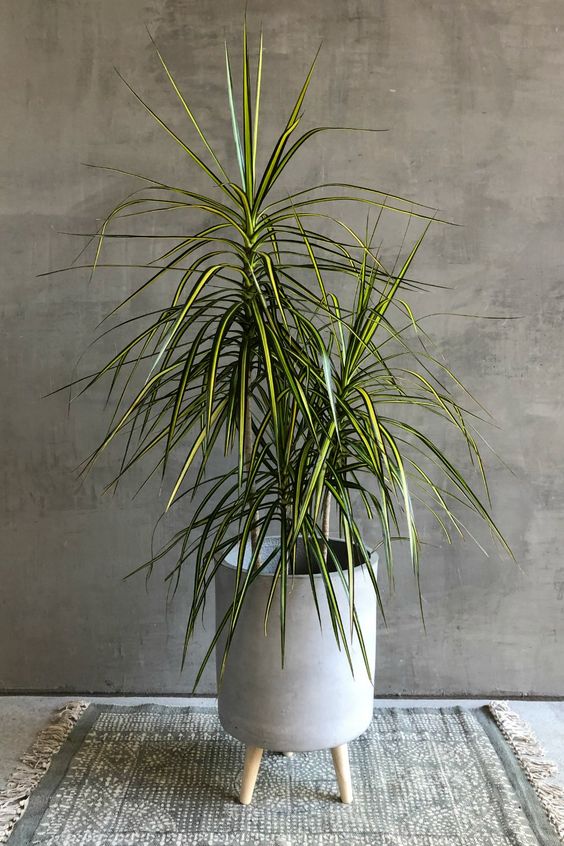
3. Dracaena Marginata – “Madagascar Dragon Tree” aka “Red Edged Dracaena”
Despite its common name, the Madagascar Dragon Tree variety does not produce the revered resin better known as dragon’s blood (this is the hallmark feature of Marginata’s cousin, Dracaena Draco). Dracaena Marginata has beautiful red-edged leaves, like Draco, and has graced homes and offices since the 1960s.
How To Identify:
- Growth : 15 – 20 ft tall, 3 – 10 ft wide (usually kept pruned to about 6 ft indoors)
- Foliage: Tufts of very narrow, straight, green sword-like leaves edged with red-purple bands. Spiral arrangement.
- Discernible Features: Slender, gray, upright structure and needs little root room. Stiff, woody stems. Leaves initially grow pointing upward, but point sideways or down as they are replaced by newer growth. When lower leaves fall off they leave a distinctive diamond shaped leaf scar.
Popular Cultivar:
- Tricolor
- Colorama
- Tarzan
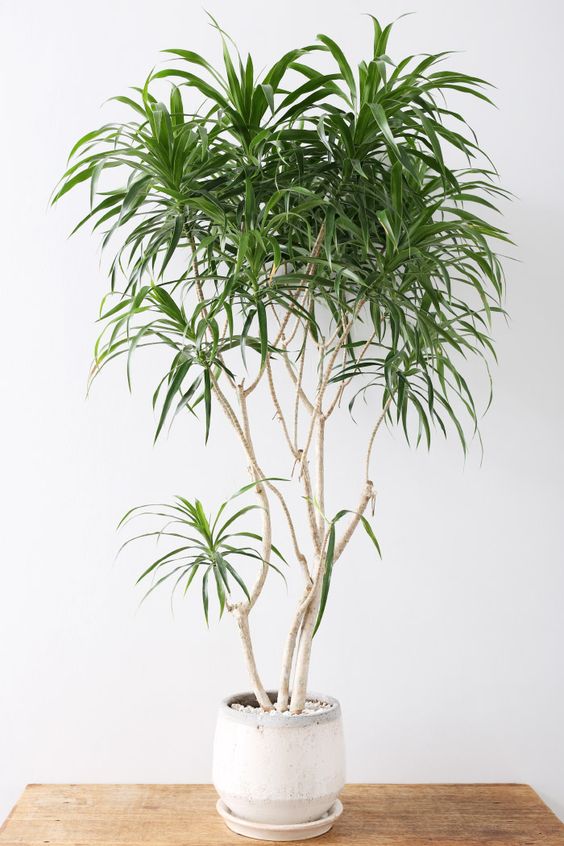
Source: Pinterest
4. Dracaena Reflexa
Often referred to as Pleomele, which was a former genus of flowering plants, this dracaena variety is known most for its ornamental beauty. Reflexa, meaning reflexed, refers to the angled leaves that grow in an elegant upward spray.
How To Identify:
- Growth : 8 – 15 ft tall, 6 – 10 ft wide
- Foliage: Reflexed, short, glossy dark green leaves. Alternate arrangement.
- Discernible Features: Thick, irregular stems. Upright growth that is bushier/more dense than some of its aforementioned cousins.
Popular Cultivar:
- Song of India
- Song of Jamaica
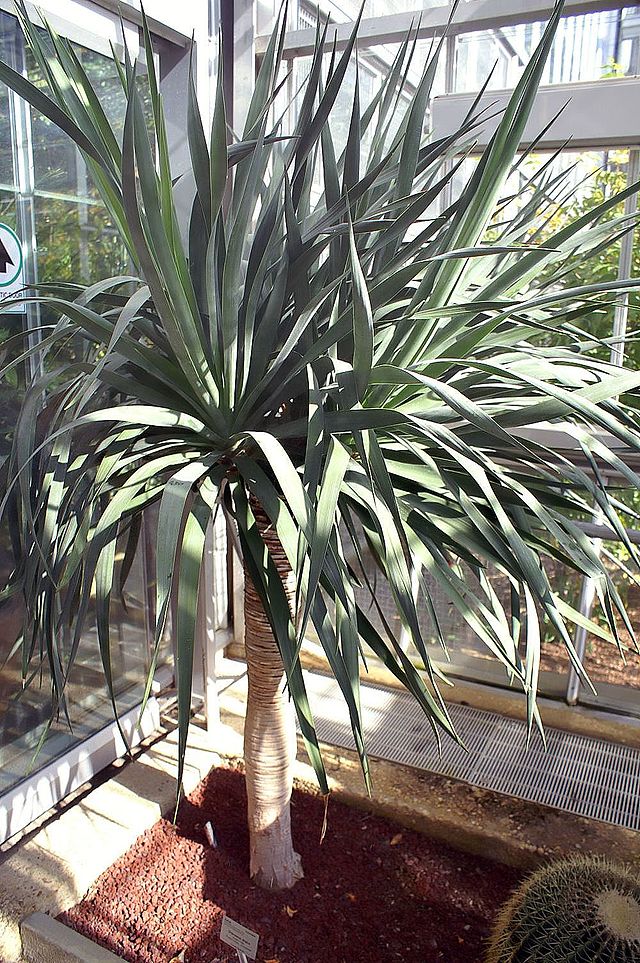
5. Dracaena Draco – “Dragon Tree”
The dragon tree is the primary source of dragon’s blood, which provides the namesake for the genus and is one of few species of tree amongst dracaena. Native to the Canary Island, these slow-growing trees can grow indoors for 10-15 years or a lifetime, with regular trimming, before outgrowing their pot.
How To Identify:
- Growth : commonly kept 2-3 feet indoors, up to 8 ft
- Foliage: Young plant: long, sharp, thin leaves resembling a rosette arrangement. Mature plant: umbrella shaped, palm-like canopy of blue-green leaves.
- Discernible Features: A thick trunk with twisted branches. Trunk produces red, gum-like resin.
Popular Cultivar:
- N/A
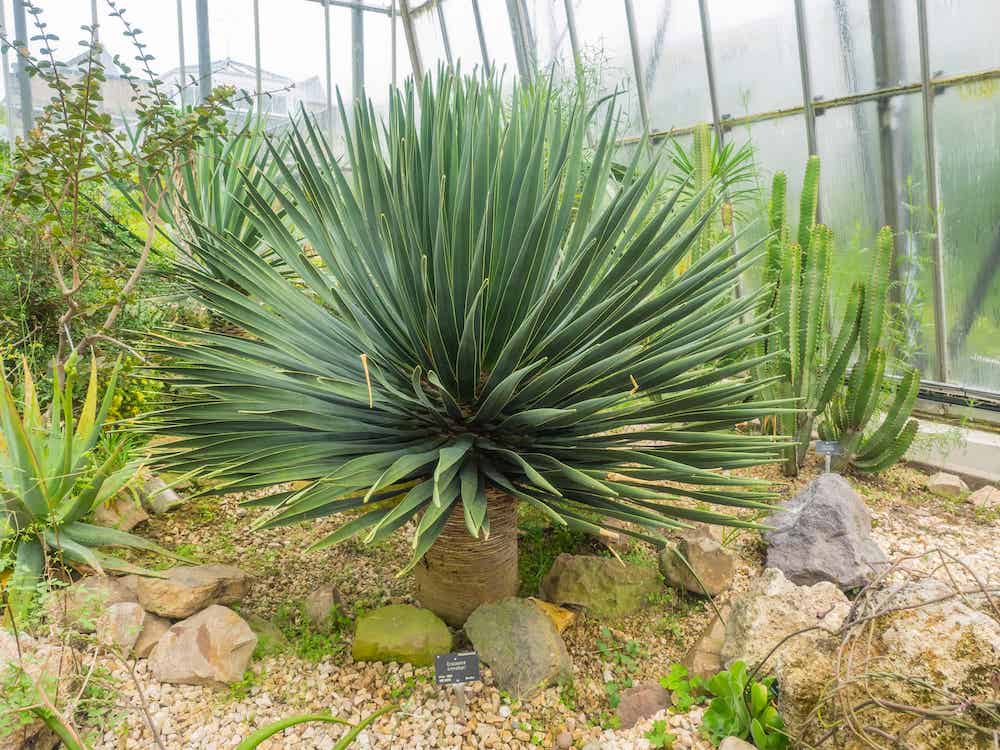
6. Dracaena Cinnabari – “Dragon Blood Tree” aka “Socotra Dragon Tree”
The latin cinnabari is derived from cinnabarinus, referring to the vermillion red colour of the sap it produces. Often confused for the dracaena draco, the dracaena cinnabari is native to the Socotra archipelago of Yemen in the Arabian sea. The most visible difference between the draco and cinnabari trees is size. Dracaena cinnabari can be kept potted indoors to a height of 3-4 feet, but grows up to 32 feet in the wild.
How To Identify:
- Growth: 3-4 feet indoors, up to 32 ft outdoors
- Foliage: Long, thin, stiff, upturned green leaves with a dracoid habitus growth habit . Rosette arrangement.
- Discernible Features: A single thick trunk and similarly thick, dichotomous branches grow a dense, umbrella-shaped crown. Growth zones have markings resembling tree rings.
Popular Cultivar:
- N/A

7. Dracaena Trifasciata – “Snake Plant” aka “Mother-In-Law’s Tongue”
Previously known as Sansevieria Trifasciata, the snake plant’s foliage differs from other dracaena leaves in that they do not grow from woody stems or branches, but rather grow in wide, yellow-green ribbons directly from the root ball. These plants were reclassified from the sansevieria genus as recently as 2017, bringing another exciting personality and aesthetic to the many dracaena types.
How To Identify:
- Growth : up to 5-6 ft tall
- Foliage: Stemless, leathery, long, variegated green, strap-like leaves. Rosette or cluster leaf arrangement.
- Discernible Features: Seemingly growing straight up out of the pot, sword-like blades grow from a mass of roots (rhizome) under the surface soil.
Popular Cultivar:
- Laurentii – “Striped Snake Plant”
- Hahnii
- Silver Hahnii – “Silver Bird’s Nest”
- Golden Hahnii – “Golden Bird’s Nest”
- Twisted Sister – “Gold Twist”
- Bantel’s Sensation – “White Stripe Snake Plant”

8. Dracaena Surculosa – “Gold Dust”
This naturally variegated tropical plant is another gorgeous decorative addition to any room. Fresh green foliage is speckled in a way that makes you wonder if Tinkerbell recently made the rounds with pixie dust. These woody stemmed, tree -like plants are lush and elegant at the same time, bringing a sense of abundance to any indoor space.
How To Identify:
- Growth : 2 – 3 feet tall
- Foliage: Dark green leaves with spots of yellow or cream. New growth appears as tightly rolled cones. Opposite/whorled leaf arrangement.
- Discernible Features: Thin, upright, copper colored branches. The spotted pattern resembles gold pixie dust blown onto the leaves.
Popular Cultivar:
- Florida Beauty

9. Dracaena Goldieana – “Zebra Striped Dragon Tree” aka “Green Zebra Plant”
Also called a “Queen of dracaena”, this dracaena variety is one to behold. Broad, boldly heather-striped leaves with contrasting undersides command attention. This dracaena type is well-suited for tables and elevated pots so you can enjoy its foliage.
How To Identify:
- Growth : up to 10 ft tall
- Foliage: Ovate, broad, smooth green and silver/grey cross banded leaves with full margins.
- Discernible Features: Young foliage has a red underside. Banding on leaves is patterned such that it resembles zebra stripes
Popular Cultivar:
- N/A
How To Best Care For Dracaena
Although these plants are generally self-sufficient and low-maintenance, they do still require some care. Ensuring ideal conditions and keeping up a care routine will give your dracaena a longer life and allow you to enjoy your plant at its most vibrant!
Light
Dracaena types can grow well in low-light, making them popular in rooms that may not have many windows like bathrooms or offices. They tend to prefer and thrive in indirect bright light or partial shade, and should never be left in direct sunlight.
Soil & Watering
Well-draining potting soil mix with organic materials is the key to a happy dracaena plant. While they are drought resistant and can go weeks without being watered, they love a good drink now and again.
It’s best to let the soil dry completely before watering dracaena. Overwatering is one of the most common ways the well-meaning plant parents kill dracaena – so no smothering!
Note: dracaena are very sensitive to fluoride – if your tap water has a lot of fluoride in it, consider using filtered water.
Temperature & Humidity
Apart from cooler temperatures (less than 55 degrees Fahrenheit), these easygoing plants are happy in most room temperatures and indoor living environments. If you live somewhere with colder winters, be mindful of where you place your dracaena in relation to outdoor drafts or standing heaters.
Fertilizer
Dracaena are considered low feeders and don’t require much fertilizer at all in order to thrive indoors. If you do decide to give your plant a treat, do so as sparingly as once or twice a year in the autumn and/or spring.
Regular pruning, rather than fertilizing, will give you the best growth results for all types of dracaena.
Problems & Pests To Watch Out For With Indoor Dracaena Plants
Small pests like aphids and spider mites are the most common in these tropical plants. Fortunately, these guys can easily be cleared away with insecticidal soap or neem oil.
If you struggle to keep pests away from your dracaena, follow up any insect-specific treatment with general care. Healthy plants are able to fight off most of these pests on their own. Don’t rely too heavily on your dracaena’s drought resistance, and make sure to get into a good watering schedule to prevent infestations.
Be mindful of what kind of minerals might be in the water or potting mix you’re using to nourish your dracaena. If you notice otherwise healthy, green leaves beginning to yellow and drop, this could be a sign of either overwatering or elevated fluoride levels. Overwatering can also lead to root rot in snake plants which, left unattended, will kill your plant.
Botanical History of Dracaena
So what is the connection between she-dragon of Greek mythology and these plants that originate, for the most part, in Africa?
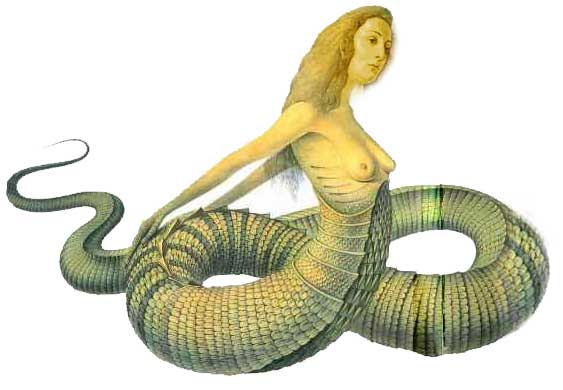
(plant pun warning)
I mean, the tail is just the beginning 😉
In Greek mythology, a drakaina is any female serpent or dragon with human features. The most well known drakaina in Greek mythology is the goddess Echidna, who was a mistress of Zeus and the daughter of a Libyan Queen. In jealous rage, Hera, Zeus’ wife, transformed Echidna into a vampiric, dragon-like beast. Out of rage over her husband’s wandering gaze, Hera cursed Echidna with an eternally staring gaze (while Zeus continued riding around in his golden chariot… not exactly justice, am I right?!). Unable to close her eyes, Drakaina couldn’t bear to witness sunlight, Zeus or anything else half worth looking at! Greek gods usually only died by slaughter, and Drakaina is said to have lived an incredibly long life due to this curse. Can you imagine how hard it was to slip one by the serpent queen with the eternal gaze?)
So, you get the drift 🙂 Both our famous drakaina and our dracaena genus share:
- Gorgeous, serpent-y features
- A preference for low-light conditions
- A painfully long life (yes, if you forget to water your dracaena next time you go on vacation, it will survive to tell the tale)
A more commonly discussed source of the name of this genus is the red, gum-like resin that some types of dracaena plants produce. The sap has a number of medicinal properties and has been used throughout history in tinctures, teas, and spiritual rituals.
Popular Uses of Dracaena
Many dracaena varieties are cultivated for their usefulness in areas of health, vanity, luxury and art. This fact should make it surprising that dracaena is scientifically related to the wildly unpopular vegetable, asparagus – because, I mean, really – what can you do with asparagus? Certainly not eat it!!
Maybe paint it?
I digress.
Medicine
The resin that can be extracted from the stems of some dracaena species, commonly referred to as “dragon’s blood”, was used by the Greeks, Romans, Arabs and Chinese to heal a number of ailments. From flesh wounds to fevers, inflammation, diarrhea, ulcers, blood clotting, and more, these cultures once considered dragon’s blood a miracle cure-all of sorts.
Although modern western medicine has largely replaced herbal remedies with pharmaceutical ones, according to this 2015 study published in the Journal of Traditional and Complementary Medicine, dragon’s blood is found to effectively speed the healing of wounds! An additional study by the journal published in 2016 found that the dracaena leaves are a source of antioxidants.
While it may not be the total solution to every medical problem it was once touted as, it’s clear that the medical properties of dracena are no myth.
Spiritual Practices
The aromatic smoke produced by burning botanicals has a long history of cultural and religious significance. Incense made from dragon’s blood has been used in meditation, rituals and witchcraft for centuries; its extract is said to enhance the properties of whatever herbs it might be paired with and, that’s right – to strengthen spells.
Art And Society
The luscious red sap and resin of dracaena titillate the senses in many forms. Beyond its aesthetic beauty simply as-is, various extracts of dracaena are widely used in a variety of everyday products, including toothpaste, breath fresheners, glue, and even in cosmetics and modern luxury skincare– just to name a few.
Researchers with the Doerner Institut in Munich published a paper detailing the identification of the resin of four species of dracaena in a number of works of art between the 15th and 19th century. They noted that it was most commonly mixed to color gold lacquers, harden translucent paints and glazes, and provide strength in other binding media.
Renowned Italian instrument maker, Antonio Stradivari, famously bamboozled his competition as well as modern scientists with his unsurpassed artistry in violin craftsmanship. Lack of documentation has made it difficult to replicate his craftsmanship, so his trade secrets sadly died with him in the 1800s. It is widely rumored that dragon’s blood was one of the “secret ingredients” in the varnish he used to coat these priceless instruments, though it has yet to be indisputably proven (or disproven).
Regardless, dracaena continues to be used in varnishes for instruments, furniture, and as a dye for wood, leather, photoengraving and other materials.
Cultural Significance
You have likely heard the idiom to “extend an olive branch” as means to end conflict, but in some parts of Africa, it’s a sprig or a leaf from a dracaena shrub that does the job. In North Pare, Tanzania, farmers plant dracaena at corners and on borders of property boundaries to deter conflict over proprietorship, and the carrying or gifting of a dracaena leaf or branch is a call to conciliation or settlement. Symbolic of peace, dracaena can also be found marking grave sites and shrines throughout Africa.
In Chinese culture, representations of many dracaena species are used as symbols of strength, power and good luck. The sanderiana variety, known more commonly as lucky bamboo, is a popular gift for holidays and religious celebrations. Per ancient tradition, the number of stems on the plant signifies the number of wishes to be imparted on the person receiving the gift.
Final Thoughts on Dracaena Types
The dracaena genus is truly a gift from mother earth, appearing in mythology, art, craft, industry and homes throughout history and around the world. Whether you’re looking to start a plant family or grow the one you already have, you can’t go wrong with the abundant offerings known as dracaena.

